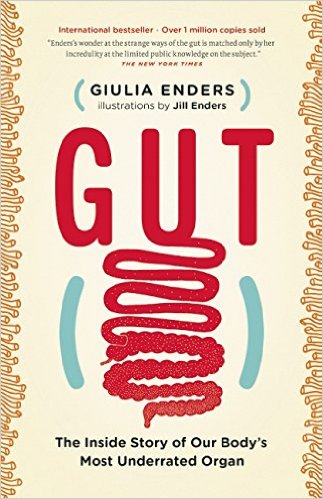The world of food is a mystifying place. Constant inundation from thousands of sources of contradictory information. Sometimes even I feel like my head is spinning trying to figure out the nutritious value of certain food items and diets.
Are eggs nutritious and usually good to consume? (YES!)
Is gluten the devil? (For some people YES, for some people, YES sometimes, for most people, not really)
Etc, Etc, Etc
 I love resources that give me more knowledge and information to help make better decisions. I like them even more when the BS-meter is low, the information comes from an academic, biased on sound scientific concepts and understanding of how our physiology works. If we understand more of how the gut processes food-stuff, we can make better decisions ourselves – even if you are not a doctor or dietician
I love resources that give me more knowledge and information to help make better decisions. I like them even more when the BS-meter is low, the information comes from an academic, biased on sound scientific concepts and understanding of how our physiology works. If we understand more of how the gut processes food-stuff, we can make better decisions ourselves – even if you are not a doctor or dietician
For this reason, I loved reading PHD candidate Giulia Enders’ book Gut: The Inside Story of Our Bodie’s Most Underrated Organ. Enders does an amazing job of painting a simple understanding of a complicated physiology that can be enjoyed through her hilarious rhetoric and applied to make positive changes that could greatly impact your health and well-being. If you value food and health, it is a must read for the lessons it provides in understanding basic gastrointestinal physiology. From roll-on-the-floor-laughing lessons on “How does pooping work?” to more mind-blowing connections between the gut and the subconscious mind, it is incredibly entertaining and enjoyable.
Here are seven things I learned that have changed the way I think about my gut and the way I treat it
- Basic Anatomy. There were not too many people who did better than me in anatomy at chiropractic college but I was shocked to learn a couple of thing about the gut that I did not know before. I learned how the semi-lunar shape of the stomach sees liquid pass along its concave edge much faster into the small intestine. In contrast, solids travel, and are digested more slowly along its outer convex edge – I had no idea. Think of all the cool things you could learn if you are starting from scratch
-

One brings life to bacteria and another death. Both have their place and time
Newborns get dipped in probiotics. Having a healthy population of gut bacteria is really important for pregnant women. Whether through vaginal birth, contact or breast milk, huge numbers of good bacteria are transferred to all the crevices of a newborn, which will dictate their early “bacteria makeup”. Children born by C-section do not receive the same number and quality of bacteria when they do not pass through the birthing canal – they get more hospital germs and are more likely to develop asthma, allergies. This reminds me of this Ted Talk that explains that our skin bacteria can dictate a mosquito’s attraction to us
- We do not get enough germs! In a world where we are obsessed with wiping every surface with sanitary wipes, where our food is so heavily sterilized and free of both good and bad bacteria, we are exposed to fewer germs. Our bodies’ immune systems get less and less training in meeting new bacteria friends than ever before. At the same time we are seeing allergy and autoimmune rates higher than ever noted before, and only in areas where these practices are used. There is likely a huge connection here. We need to have good bacteria and it is not good to live in a sterile environment – mice in sterile environments die really easily
- Our Gut Affects Our Brain. Experiments with mice have demonstrated that when fed with bacteria known to be good for the gut, their behaviour can change for the better! These mice demonstrated less stress (hormone) response to stressful situations, show more motivation, show less depressive tendencies, and perform better on memory and learning tasks. This makes sense because the vagus nerve, which travels directly between the brain and the gut (in humans and mice) can be stimulated to make humans feel comfortable or anxious based on how it is stimulated. Vagus nerve stimulation and been approved in the European Union for the medical treatment of depressive disorders in affected patients. Getting adjusted affects our brains and helps our nervous system perform better. Eating better foods can also help our brains and nervous systems function better…. if the nerves are healthy.
 PRObiotics need PREbiotics. I have to be honest that I had no idea what a PREbiotic was and why one would need them. Turns out, Prebiotics are “foodstuffs that pass undigested into the large intestine, where they feed our beneficial bacteria so that they thrive better than bad bacteria.” Some probiotic bacteria love certain nutrients that move into our large intestine that cannot be digested by out intestinal cells, which they then breakdown so our body can use them. Dietary fibre or roughage, found in foods like artichoke, asparagus, endive, bananas, garlic, onion, parsnips, black salsify, wholegrain wheat, rye, oaks and leek, can be digested by probiotic bacteria in the gut. These bacteria break chemical bonds that our own cells cannot break, which makes these once indigestible food particles, digestible. Pure prebiotics come as supplements in the form of galacto-oligosaccharides (GOS) derived from milk, and inulin derived from endives. Prebiotics are poorly researched but preliminary data is available to demonstrate that they might help protect the liver from excessive toxins produced by bad-bacteria in the large intestine, stop the binding of bad bacteria to our gut walls, improve subjective feelings of well-being, and improve calcium absorption (ITF-mix prebiotic). It makes sense that if we have trillions of bacteria in our gut, we should feed them the right stuff!
PRObiotics need PREbiotics. I have to be honest that I had no idea what a PREbiotic was and why one would need them. Turns out, Prebiotics are “foodstuffs that pass undigested into the large intestine, where they feed our beneficial bacteria so that they thrive better than bad bacteria.” Some probiotic bacteria love certain nutrients that move into our large intestine that cannot be digested by out intestinal cells, which they then breakdown so our body can use them. Dietary fibre or roughage, found in foods like artichoke, asparagus, endive, bananas, garlic, onion, parsnips, black salsify, wholegrain wheat, rye, oaks and leek, can be digested by probiotic bacteria in the gut. These bacteria break chemical bonds that our own cells cannot break, which makes these once indigestible food particles, digestible. Pure prebiotics come as supplements in the form of galacto-oligosaccharides (GOS) derived from milk, and inulin derived from endives. Prebiotics are poorly researched but preliminary data is available to demonstrate that they might help protect the liver from excessive toxins produced by bad-bacteria in the large intestine, stop the binding of bad bacteria to our gut walls, improve subjective feelings of well-being, and improve calcium absorption (ITF-mix prebiotic). It makes sense that if we have trillions of bacteria in our gut, we should feed them the right stuff!- Probiotics is not a new thing – their marketing is. Research dating back to the early 20th century demonstrated that villagers in Bulgaria were living longer and healthier than counterparts because of the prebiotic cocktail that was imparted to them by the cow’s leather bag used to carry their milk. Subsequent research has shown i) “that old people and high-performance athletes, in particular, are less prone to catching colds if they take probiotics regularly”, ii) the well documented effect of probiotics on diarrhea or a compromised immune system – their number one use – iii) and some research suggesting less risk of allergies and neurodermatitis in children with probiotic use – a case that I and the author feel to be on the side of better safe than sorry
- Custom select your bacteria when you can. Studies of probiotics might not be an accurate representation of the possibilities of consuming probiotics because one organism is isolated and studied on its lonesome in the laboratory. In reality, many probiotic bacteria work and live together and their potential benefits are likely the result of the mutual relationship between many species that form the microbiome in the gut. Try to get as many probiotic sources to accumulate many good types of bacteria such as yogurt, kombucha, and natural sauerkraut. Try to buy products that label the bacteria they contain as a best practice
We are wonderful creatures aren’t we?
- Dr Alex




